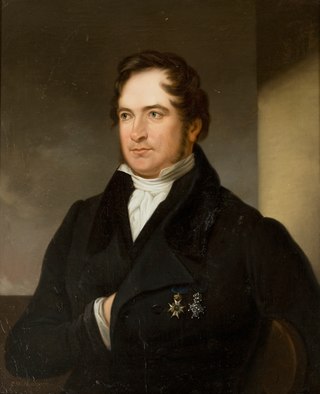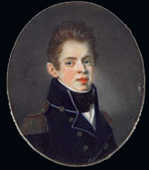
Erik Gustaf Geijer was a Swedish writer, historian, poet, romantic critic of political economy, philosopher, and composer. His writings served to promote Swedish National Romanticism. He was an influential advocate of conservatism, but switched to liberalism later in life.

The Dalarna Regiment, designation I 13, is a Swedish Army infantry unit that traced its origins back to the 16th century. The regiment's soldiers were originally recruited from the province of Dalarna, where it was later garrisoned. The unit was disbanded as a result of the disarmament policies set forward in the Defence Act of 2000. The regiment was re-raised as Dalarna Regiment in 2021. The unit is based in Falun.

The Västmanland Regiment, designations I 18 and Fo 48, was a Swedish Army infantry regiment that traced its origins back to the 16th century. It was disbanded for the first time in 1927 but later reraised and disbanded again in 1997. The regiment's soldiers were originally recruited from the province of Västmanland, and it was later garrisoned there.

The Battle of Koljonvirta i.e. the Battle of the Virta Bridge, also known as the battle ofIdensalmi, was fought between Swedish and Russian troops on October 27, 1808. The Swedish force consisted of troops from Savolax and Östergötland. After the main Swedish army had been defeated at the Battle of Oravais the army under Johan August Sandels in Savonia had to retreat in order not to be outflanked by the Russians. Sandels found a good defensive position north of Idensalmi and decided to resist the Russian advance there.

Jonas Lidströmer (1755–1808) was a Swedish inventor and officer in the Swedish Navy. Lidströmer was born in 1755 at Lagfors bruk, Medelpad, and died 1808 in Stockholm. He was a colonel-mecanicus, head of the mechanical state of the Royal Swedish Navy, Royal Inventor and advisor to the king, Knight of the Order of Vasa and eventually knighted Lidströmer.

Fredrik August Lidströmer (1787–1856) was the son of Jonas Lidströmer. He was a Swedish architect, artist and marine officer, as well as Stockholm's city architect. Raised in the naval city of Karlskrona, he came to Stockholm to help his father with the construction of the Obelisk at Slottsbacken adjacent to the royal palace, and then continued with the construction of the quays surrounding the waters of the city. He is the architect of Stockholm's oldest official park, the Strömparterren, situated between the Royal Palace in Stockholm and the Opera House, just opposite the current parliament building.
Marie Baptiste née Dumont or Du Mont was a French stage actress and singer. She is most known for her career in Sweden, where she was a leading member of the French Theatre in the mid 18th-century.

Carl Stenborg was a Swedish opera singer, composer and theatre director. He belonged to the pioneer generation of the Royal Swedish Opera and was regarded as one of the leading opera singers of the Gustavian era. He was a hovsångare and a member of the Royal Swedish Academy of Music.
Hedvig Christina Wigert née Falk was a Swedish opera singer. She belonged to the pioneer generation of performers of the Royal Swedish Opera.
Sofia Ulrika Liljegren, also known as Sofia Uttini, was a Swedish-Finnish soprano. She was likely the first professional opera singer from Finland, although she was active in Sweden. She was given the title hovsångerska.
Rosa Scarlatti was an Italian opera singer.

The Helsinki village landing, or the Combat of Helsinge, was fought during the Finnish War between Sweden and the Russian Empire on 26–28 September 1808, a part of the battles of the Turku archipelago.

Gustaf Murray was Bishop of Västerås in Sweden from 1811 to 1825.
Catharina Charlotta Swedenmarck, was a Swedish-Finnish writer and poet. Her play Dianas fest from 1775 is referred to as the first original work of its kind produced by a female during the Gustavian age.

The French Theater of Gustav III was a French language theater active in Sweden between 1781 and 1792. The French theater company performed both before the Swedish royal court in the theaters of the royal palaces, as well as before the Swedish public in Stockholm. It is known to have played a significant part in the education of the pioneer generation of actors at the Royal Dramatic Theatre.
Louise-Jeanne Du Londel, later Lefebvre, was a French actor, active in the Du Londel Troupe at the Swedish royal court in 1753–1771.

Jonas Patrik Ljungström was a Swedish cartographer, geodesist, and teacher at the Royal Institute of Technology.
Carlo Uttini (1753-1808), was a Swedish ballet dancer. He was regarded as one of the elite members of the Royal Swedish Ballet in 1773–1804, and was also active as singer of the Royal Swedish Opera (1776–79) and as an actor at the French Theater of Gustav III (1781–92) and at the Royal Dramatic Theatre (1788-1808). He was also inspector of the royal theaters for many years. He was the son of Francesco Antonio Uttini and Rosa Scarlatti.
Carolina Brunström was a Swedish ballerina. She was considered as one of the leading members of the Royal Swedish Ballet in the 1810s and 1820s.











